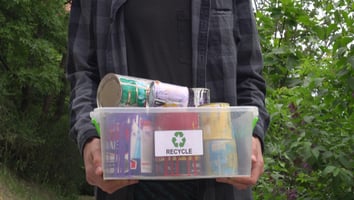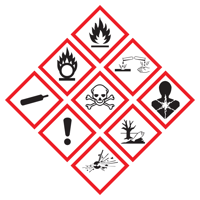One often overlooked provision of the Resource Conservation and Recovery Act (RCRA) is the...
RCRA Requirements for Generators of Hazardous Waste
Hazardous waste management is a critical responsibility for for businesses and organizations that generate hazardous waste. Unfortunately, the legal framework surrounding hazardous waste management is dense and generators are often unaware of the full requirements of the law. In this post I will address those requirements stipulated in 40 CFR Part 262, but before we dig in; if you are not quite sure what constitutes a hazardous waste, you should check out my last post where I explained the EPA's definition of a hazardous waste. Contrary to common belief, not every hazardous substance will meet the EPA's specific definition of a hazardous waste. Being able to properly identify a hazardous waste is crucial to determining generator your generator status and what is required of you by law based on that status.
Purpose of Part 262
The scope Resource Conservation and Recovery Act goes well beyond setting the standards for proper disposal. The EPA also created a framework for tracking waste via the hazardous waste manifest system as well as set standards for the proper handling and management of hazardous waste. This includes things like setting accumulation limits, labeling and storage requirements, setting standards for emergency procedures, pollution prevention planning, record keeping and more. The goal of each of these rules is to keep waste from sitting around and to ensure that it is being handled safely and in a way that minimizes risk of negative environmental impact.
Categories of Hazardous Waste Generator
The EPA classifies hazardous waste generators into three categories depending on how much and what kind of hazardous waste they produce. Which category you fall under as a generator will determine what rules you are required to follow. The three generator categories are:
- Very Small Quantity Generators (VSQGs):
- Generate 100 kilograms (220 pounds) or less of hazardous waste per month.
- Generate 1 kilogram (2.2 pounds) or less of acutely hazardous (P-listed) waste per month.
- Small Quantity Generators (SQGs):
- Generate more than 100 kilograms but less than 1,000 kilograms (2,200 pounds) of hazardous waste per month.
- Generate 1 kilogram or less of acutely hazardous (P-listed) waste per month.
- Large Quantity Generators (LQGs):
- Generate 1,000 kilograms (2,200 pounds) or more of hazardous waste per month.
- Generate more than 1 kilogram of acutely hazardous (P-listed) waste per month.
General Requirements for All Generators
The following are requirements of all generators, regardless of status:
Identification and Classification
All generators must correctly identify and classify their waste as hazardous according to the EPA’s criteria. This involves determining whether the waste is listed or exhibits any of the four hazardous waste characteristics: ignitability, corrosivity, reactivity, or toxicity. See my post Introduction to RCRA: Definition of a Hazardous Waste for more information on how to properly identify and classify a hazardous waste.
Proper Management of Hazardous Waste
All generators must ensure proper management of hazardous waste to prevent releases into the environment. This includes using appropriate containers, labeling, and storage practices. Labels must include the words "hazardous waste", an accumulation start date and an indication of the hazard associated with the waste (ex: "corrosive" or D002). In addition, all generators must ensure waste is disposed of properly at a facility permitted, licensed or registered to receive the waste.
Determination of Generator Status
All generators must determine what category of generator they fall under.
Specific Requirements for Each Generator Category
Very Small Quantity Generators (VSQGs)
- Accumulation and Storage: VSQGs can accumulate up to 1,000 kilograms of hazardous waste on-site without needing a storage permit.
- Disposal: VSQGs must ensure hazardous waste is delivered to a facility that is permitted, licensed, or registered to manage hazardous waste.
See 40 CFR 262.10(a)(1)(i) for the independent requirements of VSQGs, and 40 CFR 262.14 for the conditions for permit exemption for VSQGs.
Small Quantity Generators (SQGs)
- Accumulation and Storage: SQGs can accumulate hazardous waste on-site for up to 180 days (or 270 days if disposal facility is located > 200 miles away) without a permit. The total quantity on-site must not exceed 6,000 kg (13,200 pounds).
- EPA ID Number: SQGs are required to obtain an EPA ID number in accordance with Section 262.18.
- Hazardous waste manifest: SQGs are required to ship and track waste using the Hazardous Waste Manifest in accordance with Part 262 subpart B.
- Pre-transport labeling requirements: SQGs are required to properly label hazardous waste stored on site prior to transport in accordance with §262.30-262.33.
- Recordkeeping and Reporting: SQGs are required to keep and maintain records in accordance with Section 262.44.
- Training: SQGs are required to provide basic training for employees who work with hazardous waste in accordance with §262.16(b)(9)(iii).
- Contingency Plan and Emergency Procedures: SQGs are required to make basic plans to follow during an unplanned major event in accordance with §§262.16(b)(9).
- Preparedness and Prevention: SQGs are required to develop procedures to follow in the event of an emergency, according to §262.16(b)(8).
- Land Disposal Restrictions: SQGs are required to meet the standards for LDR notification and waste analysis plans under Part 268.
- Waste Minimization: SQGs must make a good faith effort to reduce or eliminate the generation of hazardous waste according to §262.27.
- Closure: Closure of waste management units is required for tanks, drip pads and containment buildings when no longer in use. §262.16(b)(3)(vi) (tanks) and Part 265, subparts W and DD.
Large Quantity Generators (LQGs)
- Accumulation and Storage: LQGs can accumulate hazardous waste on-site for up to 90 days without a permit. The total quantity on-site must not exceed 6,000 kg (13,200 pounds).
- EPA ID Number: LQGs are required to obtain an EPA ID number in accordance with Section 262.18.
- Hazardous waste manifest: LQGs are required to ship and track waste using the Hazardous Waste Manifest in accordance with Part 262 subpart B.
- Pre-transport labeling requirements: LQGs are required to properly label hazardous waste stored on site prior to transport in accordance with §262.30-262.33.
- Recordkeeping and Reporting: LQGs are required to keep and maintain records in accordance with §262.11(f). LQGs must also create Biennial Reports of waste generated during the previous calendar year according to §262.41.
- Training: LQGs are required to provide extensive training for employees who work with hazardous waste in accordance with §262.17(a)(7).
- Contingency Plan and Emergency Procedures: LQGs are required to make extensive plans to follow during an unplanned major event in accordance with Part 262 subpart M (from §262.17(a)(6)).
- Preparedness and Prevention: LQGs are required to develop procedures to follow in the event of an emergency, according to Part 262 subpart M (from §262.17(a)(6)).
- Land Disposal Restrictions: LQGs are required to meet the standards for LDR notification and waste analysis plans under Part 268.
- Waste Minimization: LQGs are required to have a waste minimization program in place to reduce or eliminate the generation of hazardous waste according to §262.27.
- Air Emissions: LQGs are required to control hazardous air emissions from tanks and containers according to Part 265 subparts AA, BB and CC.
- Closure: Closure of waste management units is required for all unit types in accordance with §262.17(a)(8) and Part 265, subpart W for drip pads.
Conclusion
As you can see, hazardous waste generators must contend with an overwhelming amount of regulation, particularly SQGs and LQGs. Compliance with these rules is essential not only to avoiding costly fines and penalties, but also to protecting the health and safety of workers and the environment. If you still have questions about what may be required of your business or organization, please feel free to drop us a line.



